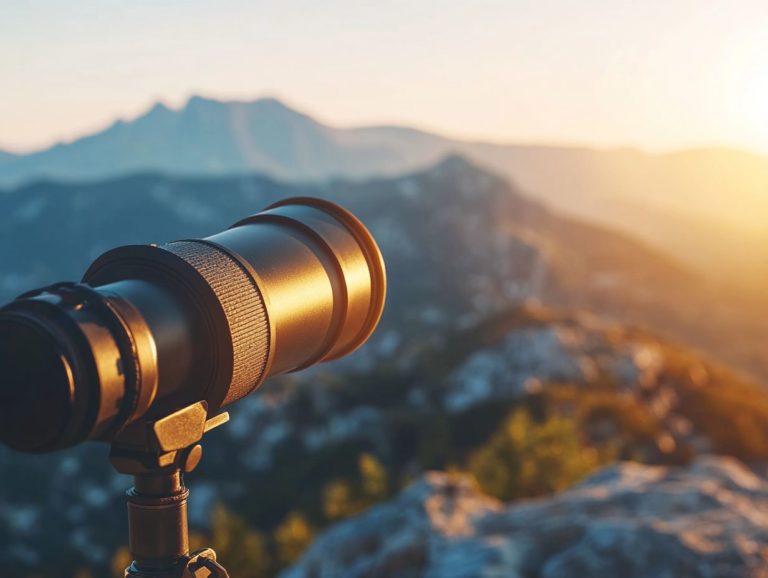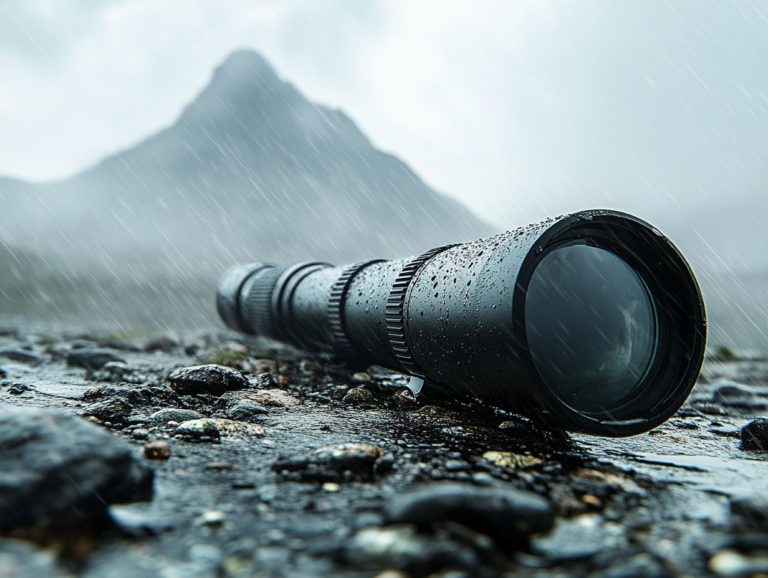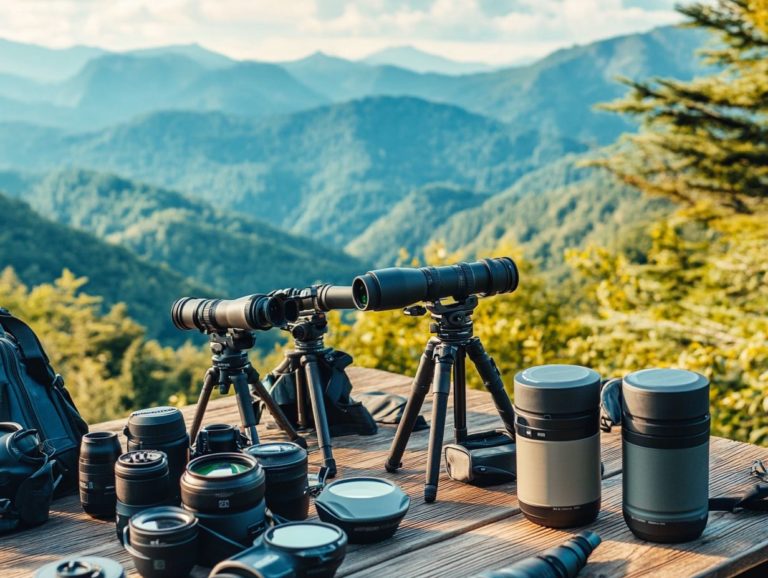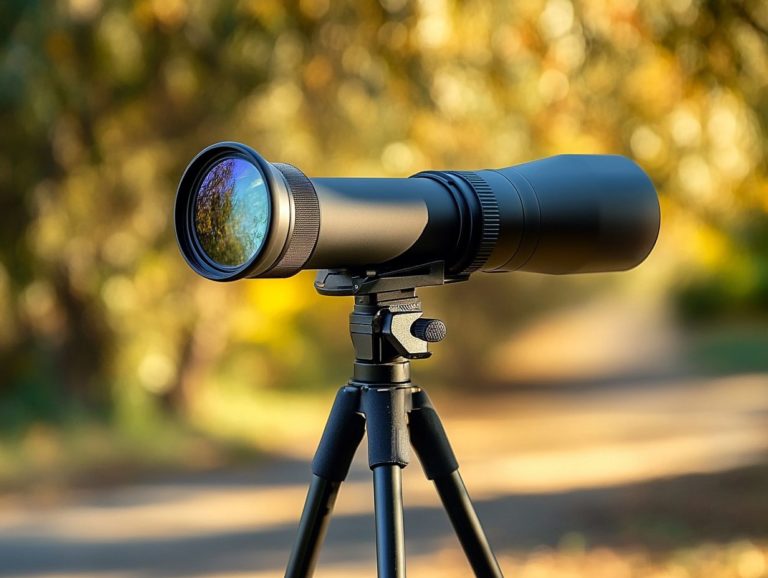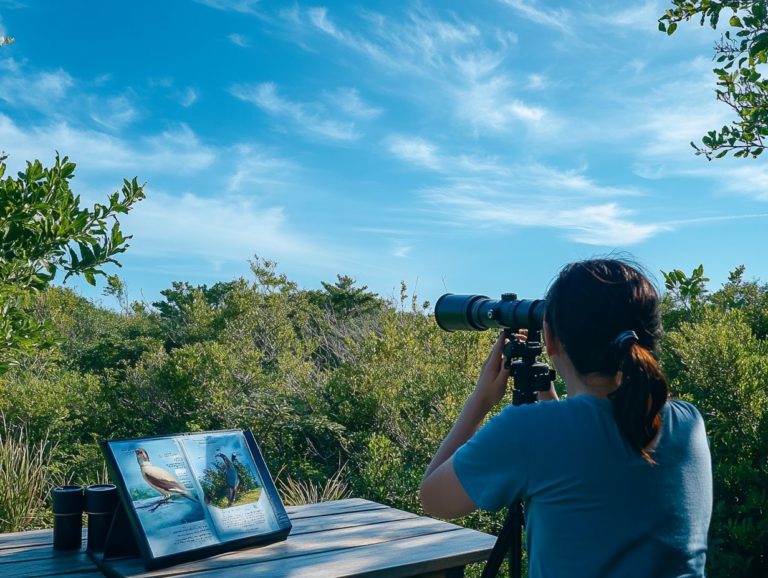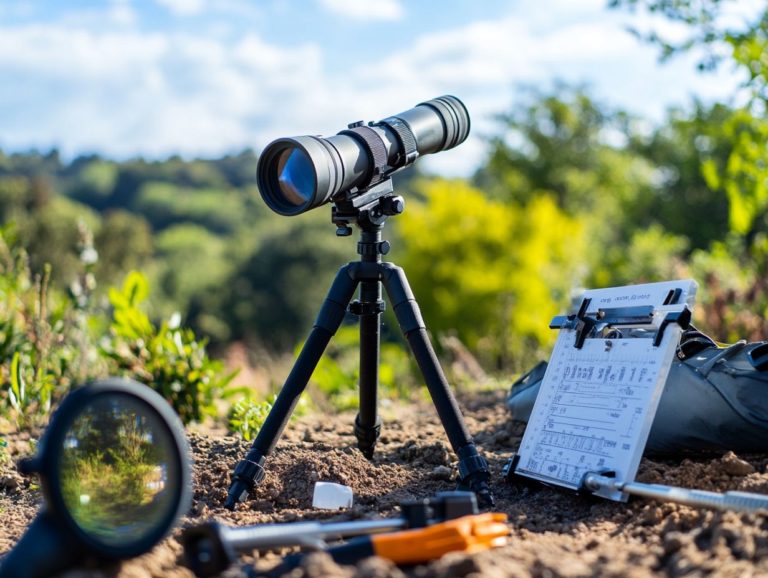Understanding Field of View in Spotting Scopes
A spotting scope stands as a vital instrument for outdoor enthusiasts, providing exceptional magnification and clarity for pursuits like birdwatching and hunting.
One crucial aspect that significantly impacts its performance is the field of view (FOV). This discussion delves into the importance of FOV, the various factors that influence it, and the methods for calculating and maximizing it to elevate your experience.
Regardless of whether you re just starting out or have years of experience, grasping these elements will undoubtedly enhance your proficiency with a spotting scope.
Here are some key takeaways:
Contents
- Key Takeaways:
- Importance of Field of View
- Factors Affecting Field of View
- Calculating and Measuring Field of View
- Maximizing Field of View
- Frequently Asked Questions
- What is field of view in spotting scopes?
- Why is understanding field of view important when choosing a spotting scope?
- How does magnification affect the field of view in spotting scopes?
- What is the difference between angular and linear field of view?
- Can field of view be adjusted on a spotting scope?
- Is a wider field of view always better in spotting scopes?
Key Takeaways:
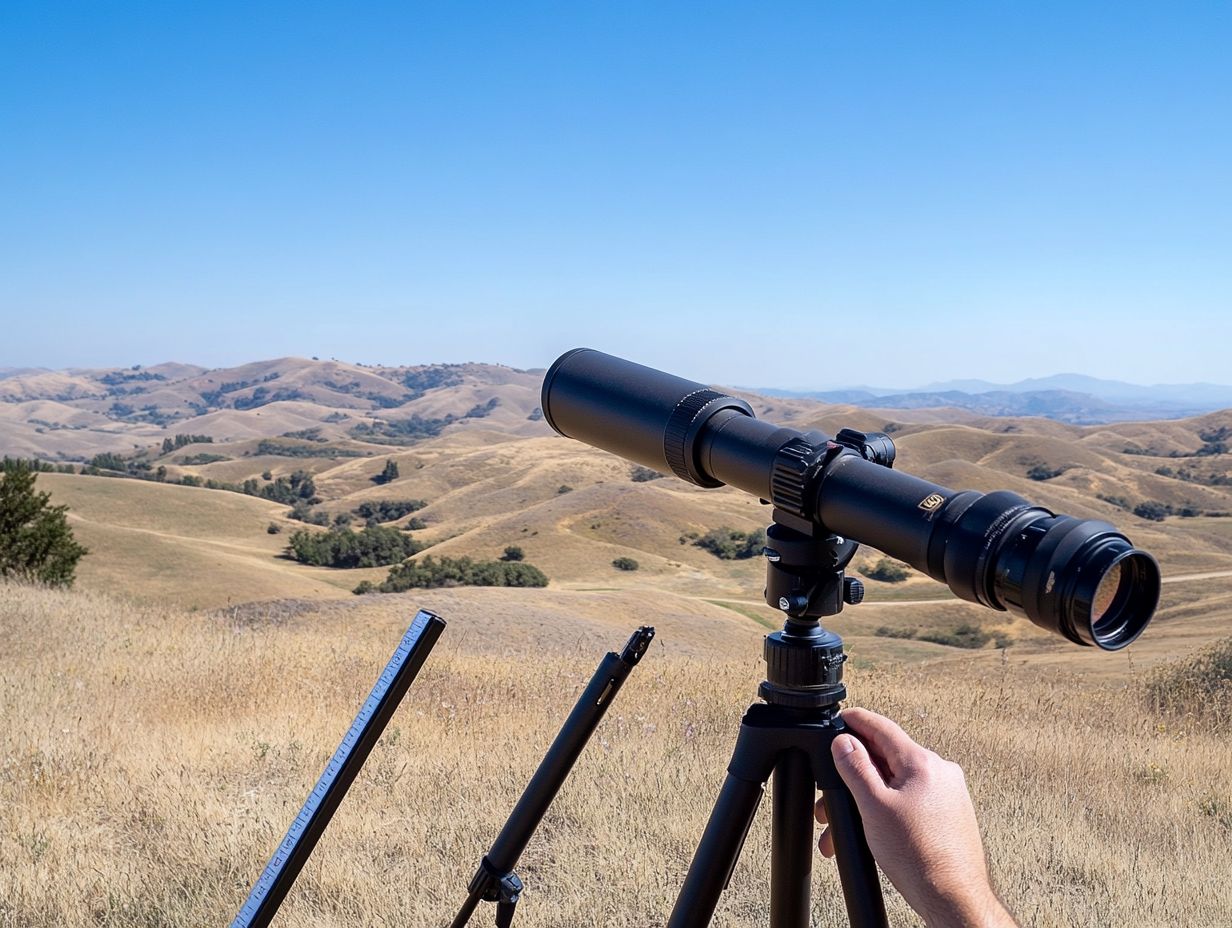
- A spotting scope is a specialized telescope used for magnifying and clarifying distant objects.
- Understanding and considering the field of view is crucial when choosing and using a spotting scope for an optimal viewing experience.
- Factors such as optical design, lens quality, magnification, and eyepiece selection all play a role in determining the field of view of a spotting scope.
What is a Spotting Scope?
A spotting scope is a remarkable tool designed for your most detailed observations of distant subjects, making it essential for backcountry hunting, birding, and wildlife viewing. Typically outfitted with high-quality glass, these scopes enable you to zoom in on your targets, offering an expansive field of view that enhances your situational awareness even in diverse conditions.
Take, for instance, the Razor 13-39×56 from the Vortex lineup; it exemplifies advanced technology, delivering exceptional image quality through its fully multi-coated lenses and a type of prism that improves brightness and clarity.
Unlike standard binoculars, a spotting scope provides superior magnification capabilities, often ranging from 15x to 60x or more. This proves invaluable when you’re trying to spot game at extended ranges. Their design caters to stability and precision, often featuring a sturdy tripod mount that enhances your observation experience. Many models include adjustable eyecups for comfort during those long viewing sessions.
The versatility of a spotting scope shines particularly in backcountry settings, as it effortlessly adapts to various lighting conditions while delivering crystal-clear imagery. You’ll appreciate the intricate details of nature from the vibrant plumage of birds to the subtle movements of elusive wildlife like never before.
Importance of Field of View
When selecting a spotting scope, the field of view (FOV) is a critical factor you must consider. It significantly impacts your ability to track moving targets and maintain situational awareness in various hunting conditions.
A wider field of view grants you the context needed for observing wildlife. A narrower field offers a more focused and detailed look at specific targets. This difference can make or break your outdoor adventure!
Why Field of View Matters in Spotting Scopes
The field of view (FOV) is crucial in spotting scopes, as it directly influences your ability to track moving targets and maintain situational awareness in dynamic environments. Whether you re hunting in the Great Smoky Mountains or observing wildlife, a wider FOV greatly enhances your capacity to spot and follow subjects, providing vital context for making informed decisions.
Consider tracking a flock of birds in flight; with a spotting scope that boasts a broader FOV, you can keep the entire group in view, making it easier to anticipate their movements. In the dense underbrush of mountainous terrain, a narrower FOV might seem appealing for zooming in on specific details, but it often leads to losing sight of the bigger picture.
Striking a careful balance between FOV and magnification is essential for optimizing performance, whether you’re watching migrating elk or searching for elusive birds. Ultimately, selecting the right field of view can significantly enhance both the efficiency and enjoyment of your outdoor experiences.
Factors Affecting Field of View
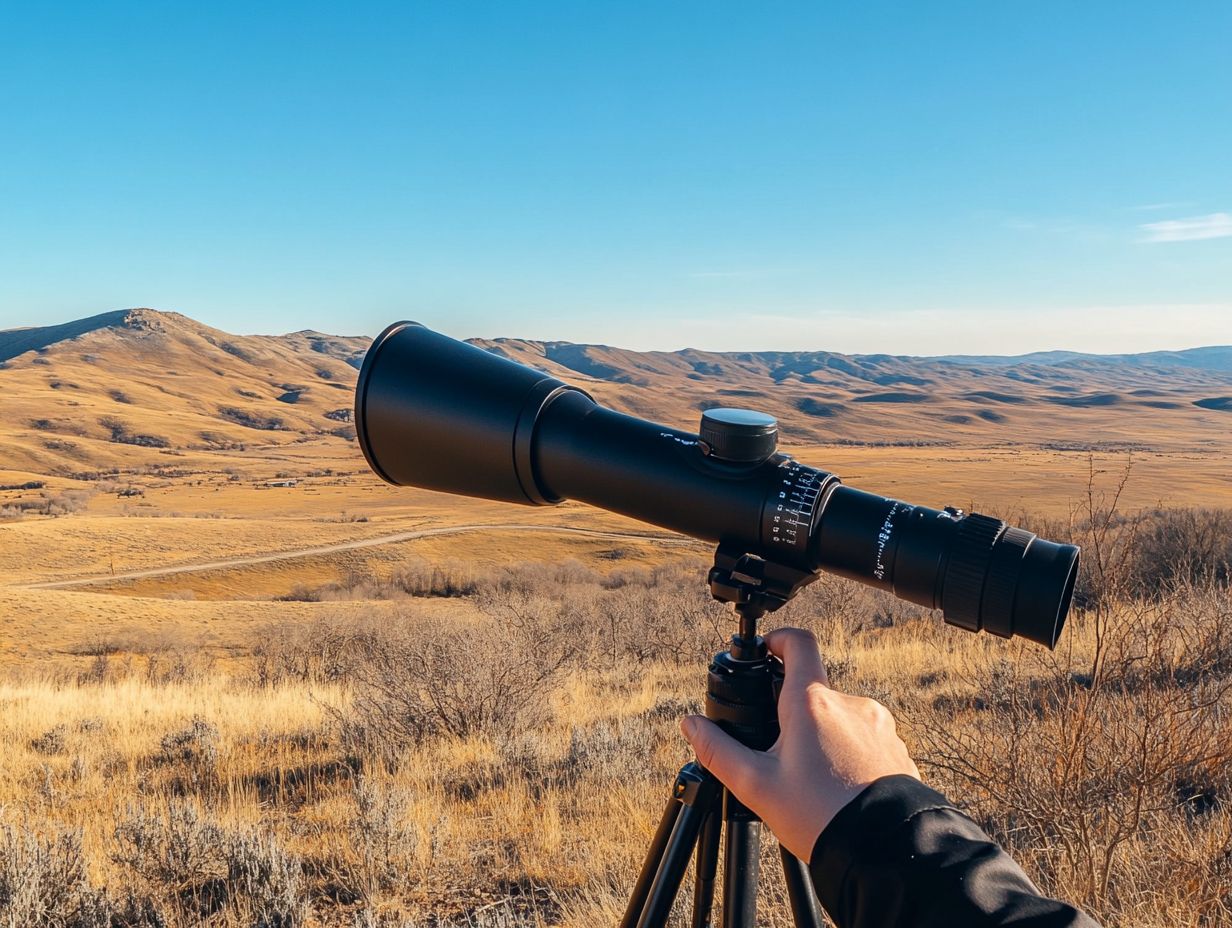
Several factors influence the field of view in spotting scopes, including optical design, lens quality, magnification levels, and eyepiece selection. By understanding the technology behind spotting scopes, you can make informed decisions when selecting the ideal scope for your needs.
Understanding these factors will empower you to find the perfect spotting scope! This knowledge will help you achieve an optimal balance between image quality and usability, especially when considering lens coatings and lens size across diverse field conditions, enhancing your overall experience in the great outdoors.
Optical Design and Lens Quality
Optical design and lens quality are important in determining the effectiveness of spotting scopes, as these elements have a direct impact on image quality, clarity, and brightness. When you choose high-grade glass paired with advanced lens coatings like fully multi-coated optics and Bak4 prisms, which help improve light-gathering abilities you significantly enhance performance, making these features critical for backcountry hunting and wildlife observation.
These components help you see sharper details, especially in low light, which is particularly beneficial during those early morning or late evening hunts.
Multi-coated lenses work to minimize glare and reflections while maximizing light transmission, resulting in brighter and more vibrant images that enhance your viewing experience.
The selection of prisms also plays a major role in the scope’s compactness and overall light-gathering abilities. Using high-quality spotting scopes makes it much easier to pinpoint distant targets, whether you’re observing wildlife or tracking game, ultimately elevating your enjoyment and effectiveness across various hunting environments.
Magnification and Eyepiece Selection
Magnification and eyepiece selection are crucial elements when you’re choosing a spotting scope, as they directly influence your ability to zoom in on distant subjects and achieve effective close focus. With the ability to select different magnification powers, you can tailor your viewing experience, adapting effortlessly to various conditions and target distances.
In the rugged terrains of backcountry hunting, the right magnification can make all the difference between a successful observation and a missed opportunity. For instance, lower magnification settings are ideal when tracking large game across expansive fields, where clarity and field of view are paramount. On the other hand, higher magnification becomes essential when you’re trying to pinpoint details on distant wildlife or identify species from afar.
Variable zoom options offer the flexibility you need, allowing for seamless transitions between close focus perfect for inspecting wildlife behavior and extended reach for those far-off targets. Ultimately, selecting the appropriate eyepiece and magnification not only elevates your overall viewing experience but also significantly impacts your success rates in the field.
Calculating and Measuring Field of View
You must calculate and measure the field of view (FOV) to unlock the true potential of your spotting scope, enabling you to make informed choices while you’re in the field.
Precise FOV measurements allow you to select the right equipment, enhance your hunting experience, and elevate your overall situational awareness as you observe wildlife or track game, particularly with hunting rangefinders.
Methods for Determining Field of View
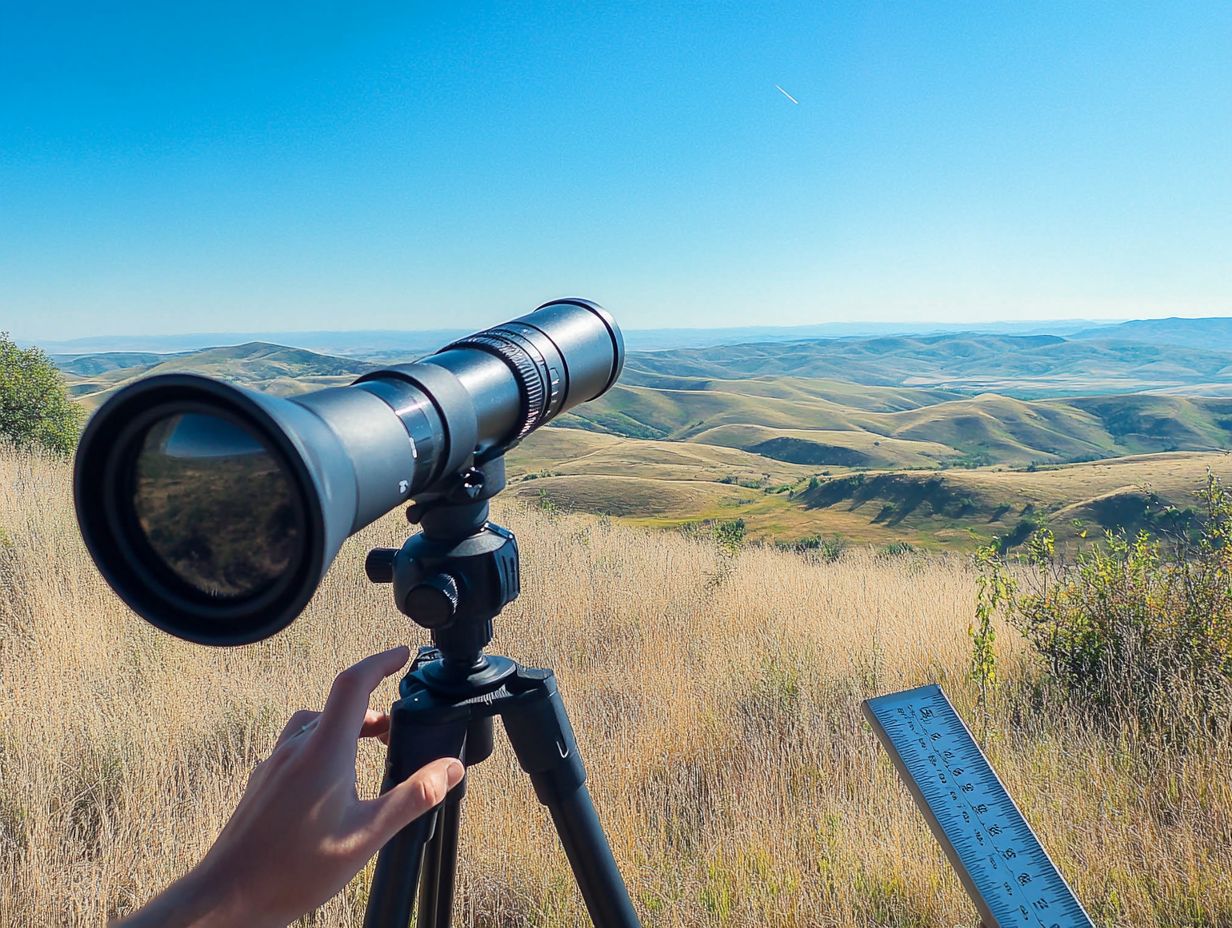
Several methods are at your disposal for determining the field of view (FOV) of spotting scopes, each providing different levels of precision and insight. Knowing these methods helps you choose the best spotting scope for your adventures, ensuring you maximize your observational capabilities during backcountry hunting or wildlife viewing. For a comprehensive overview, check out Understanding Spotting Scopes: A Beginner’s Guide.
One common approach involves utilizing known distances. You measure a specific area at a set distance and calculate how much of that area is visible through the scope. It may take a little effort, but you’ll gain valuable insights into the performance of different spotting scopes.
You can also use a ruler or measuring tape to check the visible width from a set distance. This is great for quick assessments.
By incorporating these practices, both amateur and seasoned outdoor enthusiasts can choose the ideal model tailored to their unique viewing conditions, including options for compact spotting scopes.
Maximizing Field of View
Maximizing the field of view (FOV) of your spotting scope can greatly elevate your experience across various hunting conditions. This enhancement allows for improved tracking of moving targets and sharpens your situational awareness.
By employing targeted tips and techniques, you can harness the full potential of your equipment, ensuring every outing is as effective and enjoyable as possible.
Tips for Getting the Most Out of Your Spotting Scope, including the use of a tripod essential for stable viewing.
To truly maximize your spotting scope experience, it s essential to approach it with strategy and adaptability to the ever-changing hunting environment. By employing key tips like mastering tripod usage and making thoughtful equipment adjustments you can elevate your observational prowess and achieve remarkable results.
A critical consideration is ensuring your spotting scope is securely mounted on a robust tripod. This not only stabilizes your view but also prevents fatigue during those lengthy observation sessions, allowing you to focus completely on your target.
Take the time to familiarize yourself with the scope’s settings, adjusting for varying light conditions. For instance, increasing magnification in low light can make it much easier to spot distant game.
Employ techniques such as scanning from left to right while momentarily holding your breath; this can significantly enhance your field of view and minimize shake.
Consider practical examples like using a lightweight tripod for ease of movement or choosing a heavier one for added stability in windy conditions. This thoughtful approach allows you to track and observe wildlife with unparalleled precision.
Frequently Asked Questions
What is field of view in spotting scopes?
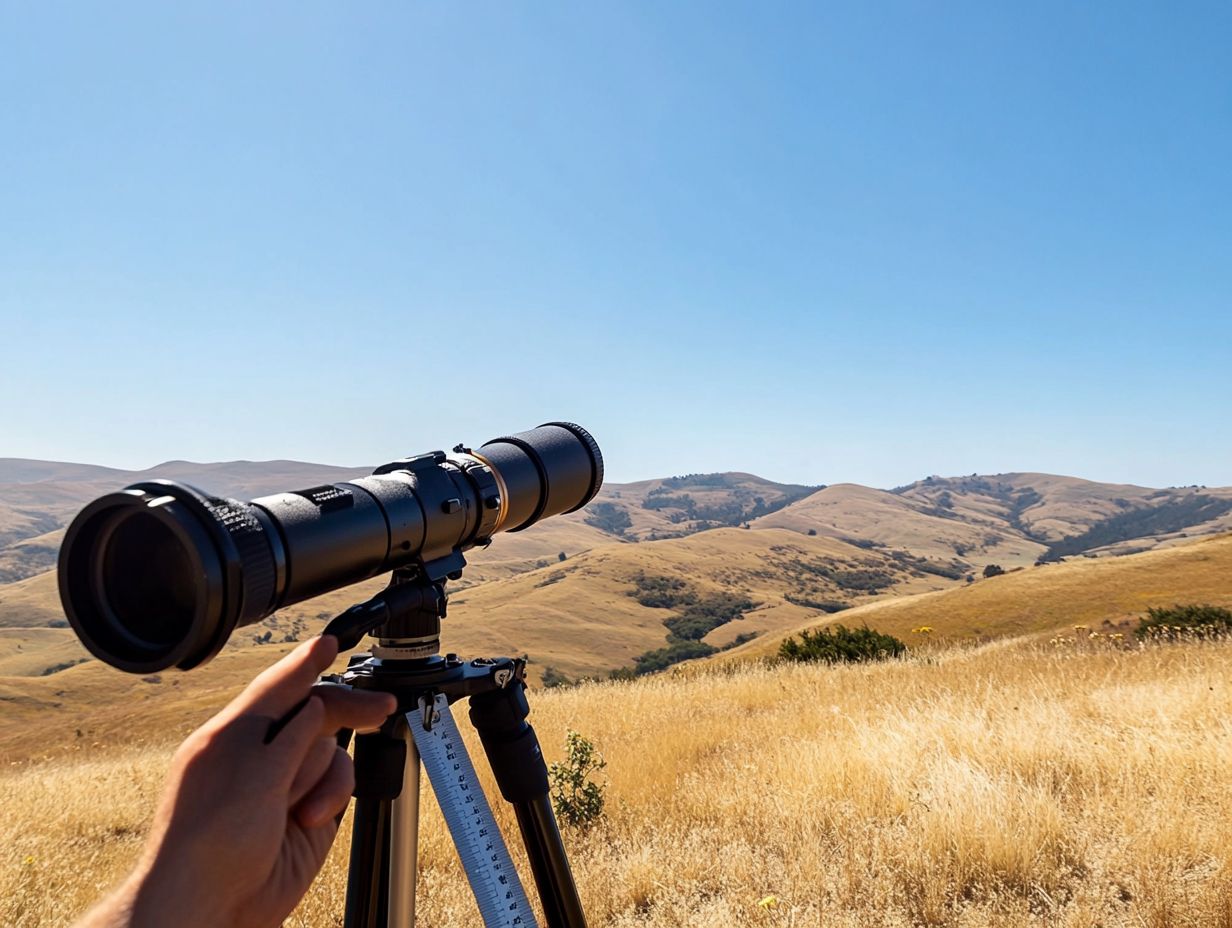
Field of view describes the area visible through a spotting scope. It is measured in feet or meters at a specific distance, such as 1000 yards. There are different aspects of field of view, including angular vs straight measurements, which can be crucial for birding or wildlife viewing.
Why is understanding field of view important when choosing a spotting scope?
Understanding field of view helps you see how much of a scene is visible through the spotting scope. For more details on this, refer to understanding spotting scope specifications. A wider field of view is great for scanning large areas, like during backcountry hunting.
A narrower field of view is better for spotting small details, which is often needed with high magnification.
How does magnification affect the field of view in spotting scopes?
Magnification can change the field of view in spotting scopes. Higher magnification usually results in a narrower field, making it harder to track moving targets.
In contrast, lower magnification gives you a wider view, which is useful for following action.
What is the difference between angular and linear field of view?
Angular field of view measures the width of what you can see in degrees. Linear field of view measures it in feet or meters.
Angular is more common in spotting scopes because it considers the magnification level, affecting how stable the image appears.
Can field of view be adjusted on a spotting scope?
You cannot adjust the field of view on a spotting scope. It is fixed by the scope’s design and magnification.
However, some scopes have interchangeable eyepieces that change magnification, which can affect the field of view and also brightness.
Is a wider field of view always better in spotting scopes?
Choosing the right field of view is crucial! A wider view might sound appealing, but it could compromise the clarity you need.
A narrower field of view often provides a more focused and detailed image. This is especially true when using high-quality glass and lenses treated to reduce glare.

